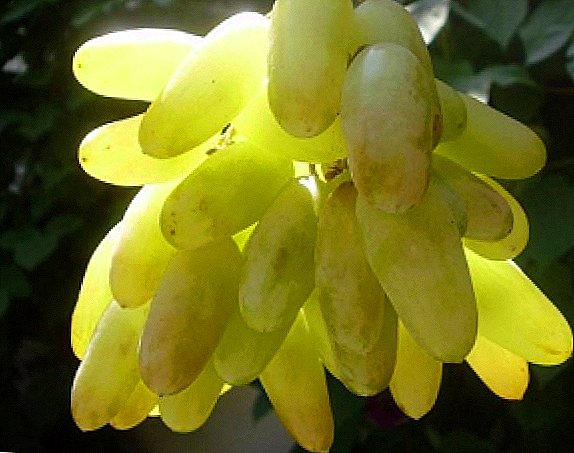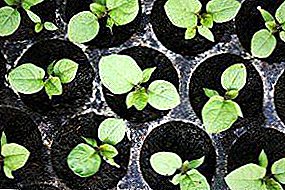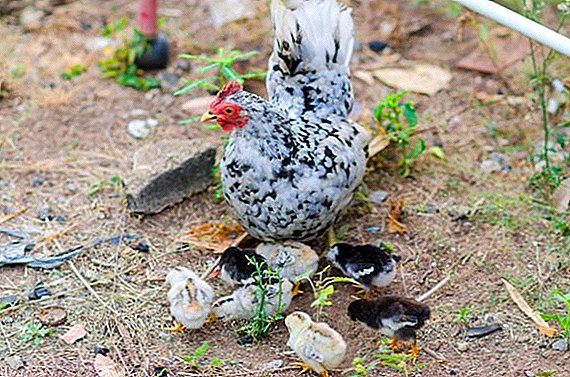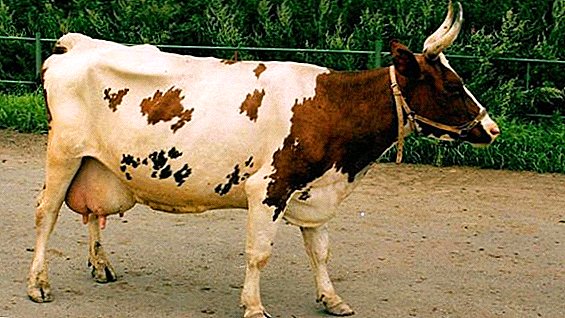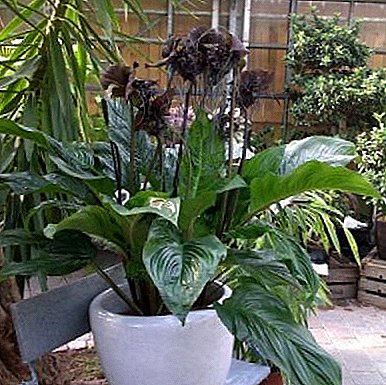
Tacca Chantrier, black lily, bat - these are the names of one of the most unusual colors, with which many legends and even superstitions are connected.
The flower of dark cherry and dark gray shades is perceived black, and thanks to the unusual structure of the inflorescence a comparison with an orchid or a lily has appeared.
Description
 Tacca chantrier (Tacca chantrieri), according to the botanical classification, has nothing to do with orchids or lilies.
Tacca chantrier (Tacca chantrieri), according to the botanical classification, has nothing to do with orchids or lilies.
It belongs to the special family Dioscoreaceae (Dioscoreaceae), the genus Tacca (Tacca), which has more than 15 plant species.
In its wild form, it grows in dense thickets of Thailand and throughout southeast Asia, from southern China to northern Malaysia. It grows only on the continent, without going to numerous islands.
Its large, bright green oval leaves can reach 60 cm in length. In Thai medicine, this plant is considered healing, medicines are made from its roots.
It was in Thailand that it was discovered by the first researchers. One can only imagine what impression the “black lily” made on the first European travelers. Among the thick and bright tropical greenery, surrounded by wide leaves, a dark spot of unusual shape suddenly appeared, with a pointed silhouette at the corners, with a fan of long mustache stamens.
The outlines of this flower close to a triangle or a trapezium could remind both the silhouette of a bat, and the physiognomy of a black cat with a long mustache, and even a devil.
REFERENCE: Taky bloom from June to December.
A photo



On our site you can read articles about other types of lilies: Marlene, Henry, Amazon.
Home care
In nature, the flower grows in a hot and humid climate. It rarely falls on direct sunlight: it is usually protected by higher plants.
At home, the bat also likes penumbra, diffused light.
For keeping at home is important:
- provide optimal temperature conditions;
- make sure that the soil is matched correctly, and that the pot is the right size and has a drainage system;
- protect the plant from drafts, temperature fluctuations, sudden changes in light and other similar stresses;
- use only clear water for irrigation;
- in the spring and summer to monitor the humidity of the air, carry out spraying.
Optimal temperature
 During the period of active growth: + 25˚С, plus or minus 2˚. During the rest period: not below + 16˚С.
During the period of active growth: + 25˚С, plus or minus 2˚. During the rest period: not below + 16˚С.
Soil composition
The soil can be prepared by yourself, you can buy one of the compositions for orchids or bromeliads.
It is important that it is light, providing good air access to the roots.
To further improve aeration, chopped moss is often added to the ground.
If there is coconut fiber, it will also enrich the soil.
One of the possible recipes:
- leaf earth (3 parts);
- peat (5 parts);
- perlite (2 parts);
- prepared pounded pine bark (part 1).
The reaction of the soil can be neutral or slightly acidic.
Top dressing
 During the growth period, takku can be fed with any complex fertilizers, but it is important not to overdo it.
During the growth period, takku can be fed with any complex fertilizers, but it is important not to overdo it.
Fertilizers are applied in reasonable quantities, no more than once every 2-3 weeks.
In winter, in the dormant period, the plant is not fed.
Transfer
Black Lily - quite sensitive plant. It does not tolerate the stresses of all kinds, including transplantation.
Therefore, we can advise not to replant it more often than once every two or three years, and choose the time for active growth for this: from mid-April to early May to early June.
If the transplant is made later, closer to the fall, the plant will be harder to recuperate.
A new pot should be slightly larger than the previous one, the ground should be properly prepared and nutritious. During the transplant, there is a great opportunity to inspect the rhizome. If the plant is healthy, you can divide the root for vegetative propagation.
Breeding
Two methods are used: vegetative and seed multiplication.
The vegetative method is on average simpler and more successful than seed reproduction.
It consists in splitting the rhizome of a plant into parts according to a certain pattern, and then planting parts of the root. Each of the ingrained fragments will give life to a new plant. It is best to split the root into pieces with a sharp knife, as living tissue is injured less.
TIP: It is desirable to powder the slices with charcoal powder or any available fungicide.
Parts of the rhizome should dry out within a day and a half. Then they can be seated in separate pots.
For successful germination of seeds you need:
- collect them no earlier than upon reaching full maturity;
- prepare the soil of optimal composition;
- maintain a temperature of 28-30 ° C, avoid temperature drops;
- be patient and attentive "parent."
 In natural conditions, where it is very hot and humid, the fruits of Takka quickly rot, and the seeds fall to the ground - to the joy of tropical wildlife.
In natural conditions, where it is very hot and humid, the fruits of Takka quickly rot, and the seeds fall to the ground - to the joy of tropical wildlife.
If it is grown at home, the fruits are harvested after full ripening, seeds are removed, which must then be washed and dried.
It is better to rinse with a weak disinfectant solution (for example, potassium permanganate).
The seeds are small, up to 4 mm, dark brown or black, with noticeable arcuate grooves.
The soil may consist of leaf soil and sand 50 to 50. Usually, the soil for cultivation is the same as for orchids.
Takka also needs good drainage, for it hypothermia and especially stagnation of water at the roots is destructive for it.
The seeds are immersed in the soil for 1 cm, provide a temperature of around 30 ° C (usually used for bottom heating) and ... patience is gained.
IMPORTANT: Shoots appear no earlier than 5-6 months.
When they are old enough and strong, they will have to be planted in pots.
Common pests
In the hot season, black lily can suffer from a red spider mite. It is not noticeable to the naked eye, but it is easy to see a light webbing on the leaves.
The pincer likes dry air, therefore, as a preventive measure, daily spraying of the plant with warm water is recommended. It is important to maintain relative air humidity in any of the available ways.
Takka Chantrie - sensitive, but not capricious plant. If the "bat" likes the conditions of life, it will feel good, blossom and bear fruit. Her amazing flowers will give you a lot of pleasant moments.



